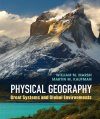About this book
The physical geography of Earth is explained through the systems that shape the planet's lands, waters, and atmosphere. Written in an easy narrative style, each chapter combines text with more than 40 single-concept illustrations. The result is a distinctive design that weaves words and illustrations together into an integrated whole. The presentation is uncluttered to keep students focused on the main themes. An entire chapter is dedicated to climate change, its geographic origins, likely outcomes, and influence on other Earth systems. A distinctive illustration program includes summary diagrams at the end of chapters that recap concepts and reinforce the systems approach. Section summaries within chapters, along with end-of-chapter review points and questions, are provided to highlight key concepts and encourage thoughtful review of the material. The instructor's guidebook highlights the core concepts in each chapter and suggests strategies to advance a systems approach in teaching physical geography.
Please note that the publisher has cancelled plans for a paperback version.
Contents
Part I. Earth's Energy, Climate and Ocean Systems:
1. Mapping our course of study
2. An overview of planet Earth: some geographic observations about Earth
3. The Sun-Earth energy system: fuel for a planet
4. Earth's radiation and heat systems over land and water
5. The great systems of global air and ocean circulation
6. Atmospheric moisture, precipitation and weather systems
7. Modern climate types and patterns
8. Climate change, past, present, and future
Part II. Earth's Life Support Systems:
9. Earth as an ecosystem: energy, food, and life
10. Biogeography: geographic distribution of plant and animal types
11. Human origins, diffusion, and the alteration of natural landscapes
12. Soil system, processes, and formation
13. Soil types, distribution, and land use relations
Part III. Earth's Water Systems:
14. The global water system
15. Runoff systems, streamflow, and watersheds
16. Groundwater, lakes, and water resources
Part IV. Earth's Rock and Mountain Systems:
17. Earth's internal system: heat, convection, rocks and the planet's skin
18. The formation and geographic organization of the continents and ocean basins
19. Mountain building systems, earthquakes, and volcanoes
Part V. Earth's Erosional and Landform Systems:
20. Geomorphic systems: rock weathering, hill slope processes, and slope formation
21. Stream systems, valley formation, and fluvial landscapes
22. Coastal systems: waves, currents, and landforms
23. Glacial systems: growth, motion, and work of glacial ice
24. Wind, sand, dust, and deserts
Customer Reviews
Biography
William M. Marsh was a professor at the University of Michigan for 30 years, where he founded the Department of Earth and Resource Science and taught physical geography. He is now with the University of British Columbia where he teaches courses in landscape analysis. He is an experienced textbook author, having written three textbooks in physical geography and two in land use applications, one of which has become a standard in the field of environmental planning.
Martin M. Kaufman has taught physical geography and geographic information systems at the high school, undergraduate and graduate levels for over 20 years. He is also an experienced textbook author. Currently, he is a professor of earth science at the University of Michigan, Flint, where he teaches the introductory sequence of physical geography courses.



































